A Comparative Study Of Typical Martial Arts And Modern Combat Sports: Highlighting The Crucial Distinctions
A Comparative Study Of Typical Martial Arts And Modern Combat Sports: Highlighting The Crucial Distinctions
Blog Article
Created By-McGinnis Burch
When you think about martial arts, do you lean much more towards the standard practices or the modern-day fight sports? Each path provides distinct benefits and experiences, formed by their philosophies and training techniques. Standard martial arts stress individual growth and discipline, while modern combat sporting activities focus on competitors and efficiency. Understanding these differences can assist you in choosing the best method for your trip. But just how do these distinctions materialize in training and ideology?
The Philosophy and History Behind Conventional Martial arts
While many individuals connect martial arts with physical fight, the philosophy and history behind traditional martial arts run much deeper. You'll discover that these self-controls highlight personal development, discipline, and respect.
Originating from ancient methods, traditional martial arts were typically established for Self-Defense and spiritual advancement. They personify principles such as balance, harmony, and self-control, assisting professionals past plain fighting abilities.
As you train, you'll not just learn strategies yet likewise obtain understandings right into the culture and worths that formed these arts. The rituals and traditions, often passed down with generations, cultivate a feeling of neighborhood and belonging.
The Competitive Nature of Modern Fight Sports
Modern fight sporting activities have actually transformed the landscape of martial arts right into a very affordable sector, where professional athletes face off in a test of ability, approach, and endurance.
You'll discover that competitors are commonly organized with rigorous rules and guidelines, ensuring justice and security. These occasions draw in large audiences, sustaining the enjoyment and intensity of competitions.
Professional athletes train rigorously, not just for physical expertise but likewise for mental strength, understanding that every detail counts in the ring. The adrenaline thrill during competitions is palpable, as fighters push their limitations to declare triumph.
Followers appreciate the athleticism and virtuosity involved, making modern fight sports a thrilling phenomenon that continues to advance and astound enthusiasts around the world.
Training Methods and Methods: A Comparative Analysis
The competitive atmosphere of modern-day battle sports demands innovative training methods that differ considerably from conventional martial arts.
In contemporary training, you'll concentrate on details strategies, sparring, and conditioning, often using drills that imitate actual fight situations. https://www.tor.com/2020/05/12/a-guide-to-condor-heroes-the-martial-arts-epic-that-influenced-all-your-faves/ 'll see an emphasis on measurable efficiency and regular competition to evaluate your abilities.
In Read Even more , standard martial arts focus on forms, katas, and philosophical trainings, commonly stressing technique and regard over competitors.
Training is normally less intense and may entail repetitive technique rather than real-time sparring.
While both strategies develop ability and physical fitness, modern-day battle sports supply a much more dynamic and adaptable training setting, preparing you for instant difficulties in the ring or cage.
Pick the course that lines up with your goals and rate of interests.
Conclusion
In selecting between typical martial arts and modern battle sports, it truly boils down to what you value many. If you're searching for individual development, self-control, and a sense of neighborhood, typical arts could be your ideal fit. However if you grow on competition and real-time challenges, modern-day fight sporting activities could be the method to go. Ultimately, both paths provide distinct advantages, so it's all about aligning your training with your individual goals and passions.
